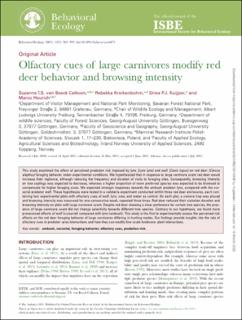Olfactory cues of large carnivores modify red deer behavior and browsing intensity
Calkoen, Suzanne T. S. van Beeck; Kreikenbohm, Rebekka; Kuijper, Dries P. J.; Heurich, Marco Dietmar
Peer reviewed, Journal article
Published version
Permanent lenke
https://hdl.handle.net/11250/3000021Utgivelsesdato
2021Metadata
Vis full innførselSamlinger
Sammendrag
This study examined the effect of perceived predation risk imposed by lynx (Lynx lynx) and wolf (Canis lupus) on red deer (Cervus elaphus) foraging behavior under experimental conditions. We hypothesized that in response to large carnivore scent red deer would increase their vigilance, although reducing the frequency and duration of visits to foraging sites. Consequently, browsing intensity on tree saplings was expected to decrease, whereas a higher proportion of more preferred species was expected to be browsed to compensate for higher foraging costs. We expected stronger responses towards the ambush predator lynx, compared with the cursorial predator wolf. These hypotheses were tested in a cafeteria experiment conducted within three red deer enclosures, each containing four experimental plots with olfactory cues of wolf, lynx, cow, and water as control. On each plot, a camera trap was placed and browsing intensity was measured for one consecutive week, repeated three times. Red deer reduced their visitation duration and browsing intensity on plots with large carnivore scent. Despite red deer showing a clear preference for certain tree species, the presence of large carnivore scent did not change selectivity towards different tree species. Contrary to our hypothesis, we found more pronounced effects of wolf (cursorial) compared with lynx (ambush). This study is the first to experimentally assess the perceived risk effects on the red deer foraging behavior of large carnivores differing in hunting modes. Our findings provide insights into the role of olfactory cues in predator-prey interactions and how they can modify fine-scale herbivore-plant interactions.

